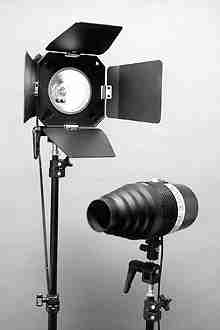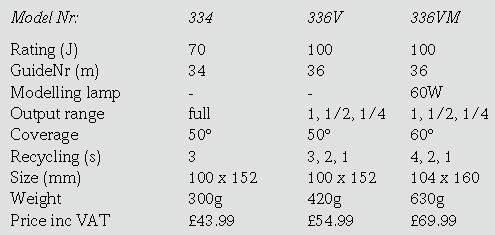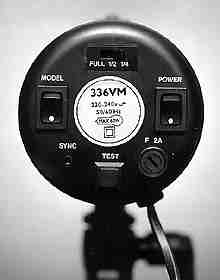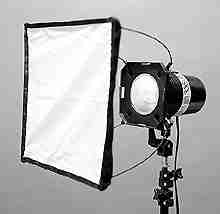
Jessop's affordable studio flash system
 How inexpensive can studio flash get? Would you believe four heads,
three stands, one free-standing reflector, a softbox, brolly, snoot, honeycomb,
diffusers, coloured filters and a case to put everything in p; all for
less than £350? That's an entire outfit for less than the price of
one well specified on-camera flashgun. And even adding a flash meter needn't
push the total above £400.
How inexpensive can studio flash get? Would you believe four heads,
three stands, one free-standing reflector, a softbox, brolly, snoot, honeycomb,
diffusers, coloured filters and a case to put everything in p; all for
less than £350? That's an entire outfit for less than the price of
one well specified on-camera flashgun. And even adding a flash meter needn't
push the total above £400.
The worker of this financial miracle is Jessop, whose Porta-flash systems
provide some of the very cheapest entries into studio flash photography.
Inevitably, specifications are basic compared to those of more conventional
monoblocs, but Portaflash units are eminently usable within their own limitations.
According to the literature, there are four ranges of Portaflash products,
though this can quickly be reduced to two. The lowest level, Series 1, is
confined to accessories for on-camera flashguns while the single unit that
previously comprised Series 4 has been discontinued in favour of a new,
forthcoming Series 3 model (of which more later). This leaves Series 2,
based on screw-in flash lamps that can be fitted into any suitable ES holder
wired to the mains, and Series 3, which is based on a lightweight self-contained
head (available with or without modelling lamp). The former will be covered
next month, leaving only the Series 3 models to be reviewed here.

As the table shows, Portaflash Series 3 units are relatively low in power,
being akin in output to mid-range camera flashguns. But this is not a criticism:
the fact is that a single on-camera flashgun can achieve much, so a similar
unit made even more versatile ought to be capable of a great deal more.
And that is the spirit in which Jessop's Portaflash equipment must be approached.
Even more significant are those prices: no, the decimal point is NOT in
the wrong place! The same pattern pervades the accessory lines too: £8.99
will buy you a set of Series 3 four-blade barn doors, while the accompanying
small soft-box is just £24.99!
It would be understandable to assume that equipment this affordable can
not have much to offer the serious user. Admittedly, professionals and experienced
amateur photographers would probably find Portaflash equipment frustrating
in isolation, but in combination with other lights, or for applications
when low outputs are required, the units are worthy of serious consideration.
This is particularly true of the 336VM, which has both variable output and
a modelling lamp (hence the V and M of the model designation). As has been
pointed out before, in certain types of photography, it can be the lowest
output available that determines the versatility of a flash unit. The Systems
Imaging 300J monobloc can be reduced only to 1/4 power whereas their 600J
model goes down to 1/16 power p; one stop lower than the smaller unit.
 On the Courtenay 300x (reviewed in March), 1/16 power equates to approximately
19J, whereas the Portaflash 336VM on 1/4 power should be running at 25J.
In practice, the two lights give much the same exposure readings. A Courtenay
300x owner might therefore have no use for the Portaflash 336VM p; except
that you could get five of the Jessop lights for one of the former! A £70
336VM is easy to justify if all you own is high-power flash. Another important
factor in favour of Portaflash lights is their portability. The weight of
the 336VM is little more than half a kilogramme and its size is just 6.5"
long with a 4" maximum diameter. If ever there was a hair-light that
fitted perfectly behind a model's head, then the 336VM is it. In use, the
336VM does all that is claimed for it, and also has one useful design feature
that ought to be noted by other manufacturers. Whereas most monoblocs have
flash ready lights on their rear panels, the 336VM's indicator is mounted
on the top of the housing. As such, the status is particularly easy to observe.
This is just as well, for the Portaflash is another light that lacks inhibition
to prevent firing at less than full power. And whilst the literature quotes
a full power recycling time of 4s, waiting a further 2s gives another 1/3
-stop of output.
On the Courtenay 300x (reviewed in March), 1/16 power equates to approximately
19J, whereas the Portaflash 336VM on 1/4 power should be running at 25J.
In practice, the two lights give much the same exposure readings. A Courtenay
300x owner might therefore have no use for the Portaflash 336VM p; except
that you could get five of the Jessop lights for one of the former! A £70
336VM is easy to justify if all you own is high-power flash. Another important
factor in favour of Portaflash lights is their portability. The weight of
the 336VM is little more than half a kilogramme and its size is just 6.5"
long with a 4" maximum diameter. If ever there was a hair-light that
fitted perfectly behind a model's head, then the 336VM is it. In use, the
336VM does all that is claimed for it, and also has one useful design feature
that ought to be noted by other manufacturers. Whereas most monoblocs have
flash ready lights on their rear panels, the 336VM's indicator is mounted
on the top of the housing. As such, the status is particularly easy to observe.
This is just as well, for the Portaflash is another light that lacks inhibition
to prevent firing at less than full power. And whilst the literature quotes
a full power recycling time of 4s, waiting a further 2s gives another 1/3
-stop of output.

Overall, the Series 3 Portaflash 336VM is both affordable and capable of
useful, if modest, performance. More than that, it is supported by two less
expensive models and will soon be joined by a more sophisticated, and more
powerful, variant p; the 340VM. This will have a remote control facility.
Incredibly, the 340VM will be priced at around £160 including the remote
control unit. Personally, I can't wait to my get hands on one!
SUMMARY RATINGS
Aesthetic & Ergonomic Design: Good
Range Of Accessories: Fair (rather basic)
Capital And Running Costs: Excellent
Performance: Fair
Overall Rating: Small and very inexpensive. Can be used alone or to supplement
other lighting systems.
Return to Photon June 96 contents

 How inexpensive can studio flash get? Would you believe four heads,
three stands, one free-standing reflector, a softbox, brolly, snoot, honeycomb,
diffusers, coloured filters and a case to put everything in p; all for
less than £350? That's an entire outfit for less than the price of
one well specified on-camera flashgun. And even adding a flash meter needn't
push the total above £400.
How inexpensive can studio flash get? Would you believe four heads,
three stands, one free-standing reflector, a softbox, brolly, snoot, honeycomb,
diffusers, coloured filters and a case to put everything in p; all for
less than £350? That's an entire outfit for less than the price of
one well specified on-camera flashgun. And even adding a flash meter needn't
push the total above £400. 
 On the Courtenay 300x (reviewed in March), 1/16 power equates to approximately
19J, whereas the Portaflash 336VM on 1/4 power should be running at 25J.
In practice, the two lights give much the same exposure readings. A Courtenay
300x owner might therefore have no use for the Portaflash 336VM p; except
that you could get five of the Jessop lights for one of the former! A £70
336VM is easy to justify if all you own is high-power flash. Another important
factor in favour of Portaflash lights is their portability. The weight of
the 336VM is little more than half a kilogramme and its size is just 6.5"
long with a 4" maximum diameter. If ever there was a hair-light that
fitted perfectly behind a model's head, then the 336VM is it. In use, the
336VM does all that is claimed for it, and also has one useful design feature
that ought to be noted by other manufacturers. Whereas most monoblocs have
flash ready lights on their rear panels, the 336VM's indicator is mounted
on the top of the housing. As such, the status is particularly easy to observe.
This is just as well, for the Portaflash is another light that lacks inhibition
to prevent firing at less than full power. And whilst the literature quotes
a full power recycling time of 4s, waiting a further 2s gives another 1/3
-stop of output.
On the Courtenay 300x (reviewed in March), 1/16 power equates to approximately
19J, whereas the Portaflash 336VM on 1/4 power should be running at 25J.
In practice, the two lights give much the same exposure readings. A Courtenay
300x owner might therefore have no use for the Portaflash 336VM p; except
that you could get five of the Jessop lights for one of the former! A £70
336VM is easy to justify if all you own is high-power flash. Another important
factor in favour of Portaflash lights is their portability. The weight of
the 336VM is little more than half a kilogramme and its size is just 6.5"
long with a 4" maximum diameter. If ever there was a hair-light that
fitted perfectly behind a model's head, then the 336VM is it. In use, the
336VM does all that is claimed for it, and also has one useful design feature
that ought to be noted by other manufacturers. Whereas most monoblocs have
flash ready lights on their rear panels, the 336VM's indicator is mounted
on the top of the housing. As such, the status is particularly easy to observe.
This is just as well, for the Portaflash is another light that lacks inhibition
to prevent firing at less than full power. And whilst the literature quotes
a full power recycling time of 4s, waiting a further 2s gives another 1/3
-stop of output. 